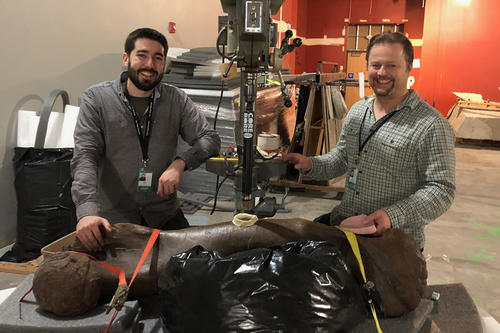University of Minnesota issued the following announcement on Nov. 25
An international team of researchers, including University of Minnesota Professor Peter Makovicky, has discovered that dinosaurs like Tyrannosaurus rex and its closest relatives had an awkward adolescence during which they got huge, while the T. rex’s more distant cousins in the allosauroid group kept on growing a little bit every year. The research gives new insight into the growth patterns of living birds that evolved from dinosaurs.
Tyrannosaurus rex was one of the biggest meat-eating dinosaurs of all time—it measured up to 42 feet long from snout to tail and would have weighed in at around 16,000 pounds. And it wasn’t alone—some of its less-well-known cousins could reach nearly the same size. Scientists have previously shown that T. rex got so big by going through a huge teenage growth spurt, but they didn’t know if that was true for just tyrannosaurs, just them and their close relatives, or perhaps all big bipedal dinosaurs.
By cutting into dinosaur bones and analyzing the growth lines, a team of researchers got their answer—T. rex and its closest relatives had huge growth spurts, while other dinosaurs grew slow and steady.
The research is published in the Proceedings of the Royal Academy B, the Royal Society's flagship biological research journal.
“We wanted to see if we got the same growth record when we sampled a variety of different bones from the same skeleton,” said Makovicky, a professor in the Department of Earth and Environmental Sciences at the University of Minnesota, scientific affiliate of the Field Museum in Chicago, and the paper’s senior author. “All these questions about how theropods grew could impact our understanding of the evolution of the entire group.”
Makovicky developed the idea for the project based on a research paper he published in 2004 about T. rex growth, and he also discovered several of the dinosaurs whose fossils were analyzed in the study.
The researchers looked at carnivorous dinosaurs from different times in the Mesozoic Era and on different continents. The question they wanted to ask was if the rapid growth pattern was a common future for all these lineages, or did they actually see differences between them.
“We wanted to look at a wide swath of different theropods, two-legged, carnivorous dinosaurs, in order to understand broader patterns of growth and evolution in the group,” said Tom Cullen, another lead author of the study.
Cullen, a scientific affiliate of Chicago’s Field Museum, worked on the study as a postdoctoral researcher at the Field with Makovicky who was the museum’s then-curator of dinosaurs.
“We particularly wanted to understand how some of them [dinosaurs] got so big—is the way T. rex grew the only way to do it?” Cullen explained.
How animals grow is complicated
The question of how an animal gets big is a surprisingly tricky one. Mammals like us tend to go through a period of extreme growth when we’re young and then stay the same size once we reach adulthood. In other animal groups, that’s not always the case.
“Growth rate really varies, there’s no one size fits all,” said Cullen, who is now a postdoctoral researcher at the North Carolina Museum of Natural Sciences. “Birds have super growth spurts and reach adult size really fast, while reptiles like alligators and various lizards and snakes have extended growth. With them, a really, really big individual is probably really old.”
Theropod dinosaurs like T. rex are related to both modern birds and reptiles—in fact, birds are the only living theropods. Scientists didn’t know whether theropods’ growth patterns were more like those of birds or reptiles, and those different growth patterns can make a big difference in how an animal fits into its ecosystem.
Getting big quickly can be a competitive advantage—it makes it easier to hunt other animals and protects the animal from getting eaten by other larger animals. On the flip side, a growth spurt takes a lot of energy and resources, and it’s easier to just get a little bigger every year.
“The amount of calories T. rex would have needed during its growth spurt would have been ridiculous,” said Cullen—like a teenage boy that ate dinosaurs instead of endless bags of bagel bites.
Clues in the fossil record
The central struggle in studying extinct animals is that we can never know exactly what their lives were like. Since we can’t directly observe a dinosaur growing the way you can a living animal today, it’s hard to know for sure how they grew. But there are clues in the fossil record that reveal growth patterns.
“Dinosaurs, like most living vertebrates will have growth lines in their bones,” Makovicky said. “They're kind of like tree rings so they grow every year. As the animal grows, the bone adds one more layer on the outside.”
To find these growth rings, Makovicky and Cullen and their colleagues sliced into fossils from dozens of dinosaurs, from ones the size of dogs and ostriches all the way up to SUE the T. rex, one of the biggest predatory dinosaurs ever discovered.
Getting access to slice and dice bones from a range of theropods was not an easy proposition, but Makovicky and Cullen reached out to colleagues across the globe. In particular, they were able to get samples from a new species of giant carcharodontosaurid from Argentina as a direct counterpoint to T. rex—this specimen was discovered and excavated by Makovicky in collaboration with his Argentinean colleagues and study co-authors Juan Canale and Sebastian Apesteguía. The authors also reached out to colleagues at the Paleontological Museum of Liaoning in China for samples of small theropods closely related to birds to get the evolutionarily broad sampling needed to determine large scale patterns in life history.
“The very first specimen that the Field Museum let me sample was SUE the T. rex,” said Cullen. “It was pretty nerve-wracking, since it’s such a famous fossil.”
The researchers used a diamond-tipped coring drill to cut a tiny cylinder out of SUE’s thigh bone. The resulting sample was a cross-section of SUE’s bone, with lines like tree rings showing where new bone had grown year after year. (The missing piece of bone, about the size of a D battery, was then filled in with brown putty—if you go see SUE at the Field Museum and look closely at their left thigh you might see it, but it’s hard to spot.)
Back in the lab, the researchers sliced samples of bone so thin that light could pass through them and examined them under a microscope. By analyzing these growth lines and examining the bones for new regions of growth, scientists can get a rough estimate of an animal’s age and how much it grew every year. There are also clues in the bone structure.
“You can see all the little areas where the bone cells have grown, and the structure of the blood vessels that passed through the bone,” Cullen said. “These vascular canals tell you roughly how fast the bone was growing. If the canals are more organized, the bone was being laid down more slowly, and if the structure is chaotic, it grew more quickly.”
Dinosaur growth is all in the family
The researchers found that the dinosaurs’ growth patterns depended on their family. T. rex and its relatives, the coelurosaurs, showed a period of extreme growth during adolescence, and then they petered out once they reached adulthood. SUE the T. rex lived to be about 33 years old, the oldest T. rex currently known, but reached their adult size by age 20.
To reach this massive size, SUE probably gained around 35-45 pounds per week as a teenager. More distant cousins, the allosauroids, could reach sizes almost as big as T. rex, but they grew slowly throughout their whole lives, with the oldest individuals reaching the biggest sizes. Among the allosauroids they sampled was the new carcharodontosaur from Argentina. It reached a size close to that of SUE but didn’t reach adult size until its late 30s to early 40s. It lived to be up to about 50 years old or more, making it the oldest individual theropod on record aside from some birds like parrots. Despite its advanced age, it had only stopped growing 2 or 3 years before becoming part of the fossil record.
The discovery opens up questions about how these predatory dinosaurs interacted with the animals around them. The plant-eating dinosaurs that lived alongside T. rex were ceratopsians like Triceratops and duck-billed hadrosaurs. They grew extremely quickly in adolescence too. The slow-growing allosauroid carnivores lived with big long-necked sauropods that also grew quickly but appear to have taken a long time to reach full size. Those trends might be related.
“We can’t say for sure, but there could be some kind of a selection pressure for the coelurosaurs to grow quickly to keep up with their prey, or pressure for the allosauroids to keep growing in size since their prey were also increasing in size,” Cullen said. “It could be that even if the sauropods kept growing their whole lives, they had so many offspring that there was always something small to eat.”
“So basically, in a way, what we're saying is there are different ways to become a giant dinosaur,” Makovicky said. “There's not one preferred way of doing it.
A big step forward
But while the research hasn’t answered all the questions about why dinosaurs like T. rex grew the way they did, Makovicky said this research is a big step forward.
“We started this research way back in 2011,” Makovicky said. “Now we have a bank of samples that will help us in the future. This is a much bigger-type of study.”
Cullen also said he is proud of this work. “It’s the culmination of many, many years of small projects building towards sort of a central goal of trying to understand growth in these animals and understand the many factors that influence these patterns,” Cullen said. “This doesn't resolve it, but this is a really big step forward.”
To read the full research paper entitled “Osteohistological analyses reveal diverse strategies of theropod dinosaur body-size evolution,” visit the Proceedings of the Royal Academy B website.
Original source can be found here.

Source: University of Minnesota


 Alerts Sign-up
Alerts Sign-up